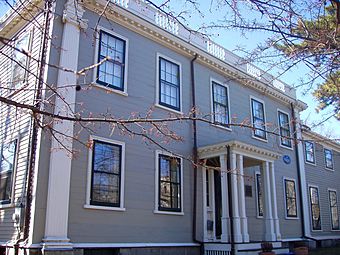Asa Gray House facts for kids
|
Asa Gray House
|
|

Asa Gray House.
|
|
| Location | 88 Garden St., Cambridge, Massachusetts |
|---|---|
| Area | less than one acre |
| Built | 1810 |
| Architect | Ithiel Town |
| NRHP reference No. | 66000655 |
Quick facts for kids Significant dates |
|
| Added to NRHP | October 15, 1966 |
| Designated NHL | January 12, 1965 |
The Asa Gray House is a historic home located at 88 Garden Street in Cambridge, Massachusetts. It is recognized as a National Historic Landmark, meaning it's a very important place in American history. This house is special for two main reasons. First, it's one of the earliest known works by a famous architect named Ithiel Town. Second, it was home to many important people from Harvard University.
The most famous person who lived here was Asa Gray (1810–1888). He was a leading botanist, which is a scientist who studies plants. Asa Gray wrote the first complete book about plants in America. He was also a strong supporter of Charles Darwin's ideas about how living things change over time.
Contents
History of the Asa Gray House
The Asa Gray House was built in 1810. It was designed by the architect Ithiel Town. This house is the earliest known building that Town designed. It was first built for a zoologist named William Dandridge Peck. A zoologist is a scientist who studies animals. The house originally stood on the grounds of the Harvard University Botanical Garden. This garden is a place where many different plants are grown for study.
Over the years, several important people lived in the house. These included another botanist, Thomas Nuttall, and two presidents of Harvard, James Walker and Jared Sparks.
Asa Gray's Time in the House
Asa Gray bought the house in 1842 and moved in during the summer of 1844. He had just been given a job as a professor at Harvard, a position he held for 45 years. Asa Gray was already becoming well-known in the world of botany.
In 1848, he published a very important book called The General of the Plants of the United States. This book was special not only for what it taught but also for how it was presented. Gray made an important discovery: he found connections between plants in North America and East Asia. This discovery helped the field of plant geography grow. Plant geography is the study of where different plants grow around the world.
Asa Gray also became famous for publicly defending Charles Darwin's book, The Origin of Species. This book shared Darwin's ideas about evolution. Gray's support for Darwin brought him a lot of attention from the public.
Moving the House
In 1910, a man named Allen Cox bought the Asa Gray House. He moved the house to its current address that same year. Today, the Asa Gray House is a private home. It was officially named a National Historic Landmark in 1965 because of its important history.
Architecture of the Asa Gray House
The Asa Gray House has a main rectangular part that is about 40 feet (12 meters) long and 36 feet (11 meters) wide. It also has a side section, called an ell, which is about 24 feet (7 meters) square. When the house was first built, it was connected to a plant conservatory, which is like a greenhouse. This conservatory was also designed by Ithiel Town.
The house has two stories and five windows across the front. It has a sloped roof that is surrounded by a low fence-like railing called a balustrade. The front of the house is covered with smooth, flat boards. The corners have flat, column-like decorations called pilasters. The other sides of the house are covered with overlapping wooden boards called clapboards.
The main part of the house has a decorative molding under the roof called a dentillated cornice, which looks like a row of teeth. The side ell has a simpler cornice. The main front door is in the center. It has narrow windows on either side and a fan-shaped window above it. A small porch, called a portico, covers the entrance. This porch is supported by square columns. The original porch was replaced when the house was moved.
There is another entrance on the side ell. This entrance is covered by an enclosed porch that was added around 1920. At the back of the house, there is an addition that was built around the time the house was moved. This addition includes a shed that used to be outside.
Inside the House
The inside of the house has a common layout for homes from the Federal period. There is a central hallway that is divided into front and back sections. Each section has a staircase. A doorway with a fan-shaped window separates these two parts of the hall. There are two rooms on each side of the central hallway.
The wooden decorations in the main rooms are not overly fancy. They have simple moldings under the ceilings and around the fireplaces. The windows have slightly flared moldings. The room downstairs in the side ell was Asa Gray's study, where he worked. It still has several wooden display cases along one wall.
Images for kids


